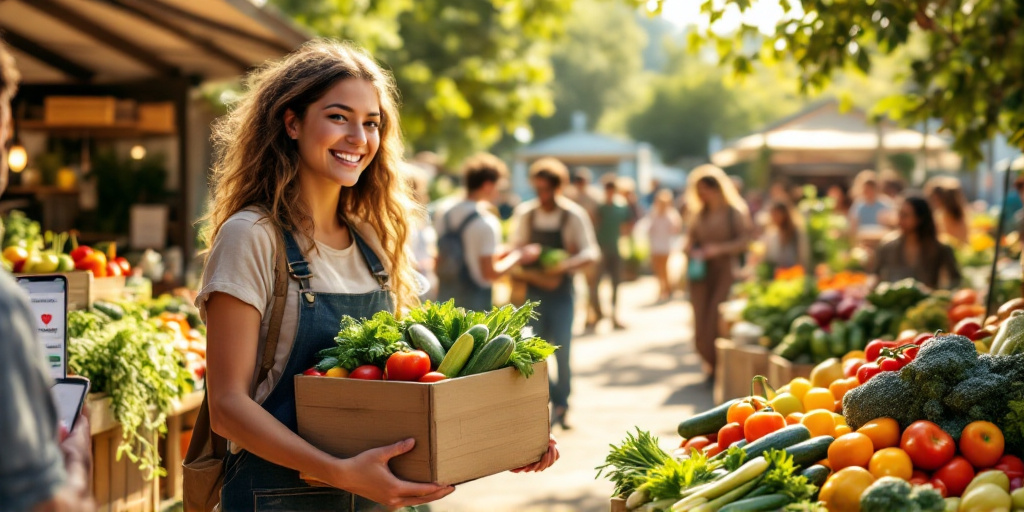I Scored $200 in Organic Groceries for Free Here’s How You Can Too
I’ll never forget that Saturday. My fridge echoed with emptiness, and my bank account felt even more desolate. I’d been committed to eating more organic food, but let’s be honest, the premium price tags were a constant battle. I was venting to my friend, a savvy shopper herself, when she leaned in with a conspiratorial smile and said, “You know, there are ways… Ways most people completely overlook.” What she revealed next changed how I shop forever. A week later, armed with her secrets, I walked away from a local farm share, my arms laden with a box overflowing with vibrant, fresh organic produce: kale that looked like it was still photosynthesizing, sun-ripened tomatoes, a zucchini the size of my forearm, and even some early, crisp apples. The retail value? Easily $200. My cost? A few enjoyable hours of my time and absolutely zero dollars. It felt like I’d cracked a delicious code.
It’s a staggering thought: Americans throw away about 80 billion pounds of food each year. That’s according to ReFED. Imagine that! Perfectly good, nutritious food, enough to make a real difference, just tossed aside. Meanwhile, many of us are meticulously planning budgets, trying to afford those healthy, organic options that often feel like a luxury. It’s a frustrating paradox, right? But what if I told you there are three game-changing (and totally legal) ways to tap into this overlooked abundance, to fill your plate with organic goodness, guilt-free, and without ever needing to glance at a dumpster? Stick with me, because I’m about to show you how.
Hack 1 The Underground Network of Free Food (No Crowbar Needed)
Forget any dramatic images of midnight raids. The most incredible stashes of free, high-quality food are often hiding in plain sight, orchestrated by everyday people and businesses who simply can’t stand to see good food go to waste. My friend Sarah, a sustainability champion with an eagle eye for value, introduced me to the app Olio. It’s brilliant! It connects you with neighbors and local businesses sharing surplus food. One day it might be a local bakery offering artisanal sourdough they couldn’t sell, the next it’s someone moving who has a pantry full of organic goodies. Then there’s Too Good To Go, another gem where restaurants and grocery stores sell their perfectly good end-of-day surplus at massive discounts sometimes so low it’s practically free. I once got a huge bag of organic veggies from a local cafe for just a few bucks, enough for several meals.
And then there are community fridges. I found one tucked beside a vibrant community center in a nearby neighborhood. It’s such a simple, beautiful concept: a public refrigerator, stocked by volunteers and local businesses with surplus food. Anyone can take what they need, and anyone can contribute. I later learned from Freedge.org that there are over 200 of these community fridges globally! It’s like a neighborhood potluck, always open. Last month alone, I read that the Brooklyn Community Fridge network redistributed 4,200 lbs of organic produce that’s like filling three entire sedan trunks! Most people miss these golden opportunities because they’re simply not clued in. The regulars? They often know the restocking schedules by heart. Pro Tip: Search ‘community fridge [your city]’ or ‘[your neighborhood] free food sharing’ on social media to uncover these local treasures.
Hack 2 Work a Few Hours Eat Organic All Week
If tapping an app feels a bit too passive, and you’re like me and enjoy a more hands-on approach that connects you to the source of your food, then this next hack is pure gold. I’m talking about Community Supported Agriculture (CSA) work shares or volunteering directly on local organic farms. Remember that $200 box of organic delights I mentioned? That was my reward from a CSA work share. I spent a glorious morning helping with weeding and harvesting. It wasn’t back-breaking labor; honestly, it was incredibly therapeutic being outdoors, sun on my face, hands in the earth. In exchange for my time, I received a bounteous share of the farm’s incredible harvest.
This isn’t about charity; it’s a direct, satisfying exchange based on reciprocity. You contribute a few hours of your effort, perhaps learn a new skill or two about sustainable farming, and you walk away with a box brimming with the freshest organic produce imaginable food that would typically cost a small fortune. It’s a profound win-win. The farm gets valuable assistance, and you get unparalleled quality and flavor. Finding these isn’t as hard as you might think. I started with simple online searches like “CSA work share near me” or “volunteer organic farm [my town]”. Websites like LocalHarvest can be great resources. Quick heads-up: Popular farms often have waiting lists for volunteer slots, so it’s wise to call ahead or check their websites. One volunteer I know consistently brings home over $150 worth of organic veggies after a single Saturday morning shift. That’s potentially $600 a month in top-tier groceries!
Hack 3 Beat the Clock Farmers Secretly Toss Perfect Food After Hours
This tip came straight from a seasoned farmers market vendor, a wonderful gentleman who grew the most amazing heirloom tomatoes. We struck up a conversation one sunny afternoon as the market was beginning to wind down. He explained a common dilemma: vendors often have perfectly ripe produce left at the end of the day sometimes too ripe to transport and reliably sell later. Rather than hauling it all back or risking spoilage, many are thrilled to offer deep discounts or even give it away to prevent waste.
Are you ready to walk away with organic gems worth a bundle, absolutely free or nearly free? The key is timing and a friendly, non-demanding approach. Set your phone alarm for ‘The Golden Hour’ the final 60 minutes of the market. This is when vendors secretly hope for rescuers for their surplus organic peaches, perfectly ripe and begging to be eaten, or slightly bruised but delicious apples. I’ll never forget the vendor with calloused hands who offered me an overripe strawberry. ‘Taste it,’ he smiled, ‘still sweet like summer sun.’ It was divine, and free! Don’t be pushy; just express genuine interest and politely ask if they have anything they need to move. And it’s not just farmers markets. The ‘ugly’ produce movement is your friend. Subscription boxes like Imperfect Foods or Misfits Market sometimes have amazing trial offers that can get you a box of slightly quirky but perfectly delicious produce for free or a pittance, saving it from an undeserved fate in a landfill.
Bonus Diet Hacks for Free Even if You’re Keto or Vegan
Think these free organic food strategies won’t work for your specific dietary needs, like keto, vegan, or gluten-free? Think again! Are you the type who sees a challenge and thinks, ‘I can absolutely figure this out’? If you’re navigating these paths, your inherent resourcefulness is about to pay off big time.
For my gluten-free friends, I once had a chat with a baker at a dedicated gluten-free bakery. She mentioned they often have day-old bread or pastries they can’t sell but are still perfectly delicious. Building a friendly rapport and asking politely near closing time can sometimes yield amazing results. The same applies to vegan cafes or health food stores with fresh daily items. For my keto friends, I’ve heard whispers of local butchers sometimes having off-cuts or bones perfect for nutrient-rich broth, often free for the asking if you’re a regular customer. And don’t forget SNAP benefits! Many farmers markets have programs like ‘Double Up Food Bucks,’ which effectively match your SNAP dollars spent on fresh produce. That’s literally getting half your organic fruits and veggies free!
3 Simple Rules to Stay Safe and Smart
So, this all sounds pretty fantastic, right? Free organic food, reducing waste, building community connections. But it’s smart to be aware. My whole philosophy is about enjoying these benefits intelligently and without any stress. The beauty of these three hacks? They are all about community, sharing, and smarts not skirting the law.
- Trust Your Senses & Sources: When using apps like Olio or Too Good To Go, or accepting end-of-market items, always inspect the food. Does it look and smell fresh? I always double-check the source (is it a known bakery or an individual I feel comfortable with?) and arrange pickups in well-lit, public spaces. Your health is paramount. If something seems off, politely decline.
- Foraging Smarts (If You Go There): If you explore urban foraging (apps like Falling Fruit can map public fruit trees), be 100% certain of what you’re picking. Many plants have look-alikes, some of which can be harmful. My unwavering rule: when in absolute doubt, leave it out. No free apple is worth a bad experience.
- Know Your Farmer/Source: With CSA work shares or direct farm volunteering, you’re typically getting food straight from the source, which is ideal. For market finds or app-based shares, a little due diligence goes a long way. The community food-sharing initiatives I’ve encountered have an incredibly high safety record because when people share, they generally care.
By focusing on these community-based, direct-from-source, and clever timing methods, you’ll be enjoying fantastic free or nearly-free organic food without a single worry. Imagine slashing your grocery bill by $200, $300, or even more each month. What would you do with that extra cash? It’s all about being smart, respectful, and wonderfully resourceful. Try one of these hacks this week. You might be amazed at what you discover!

